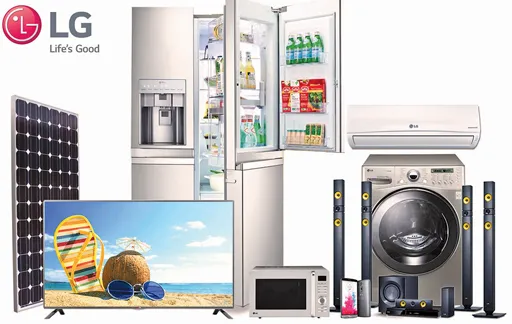This project provides a comprehensive overview of Marketing Strategy by LG India, positioning, and performance in the Indian consumer electronics market. It leverages industry data, corporate information, primary research, and news articles to analyze LG India’s strategic approach across segments like home appliances, televisions, smartphones and IT products. Students can further build on the analysis by conducting additional primary and secondary research on Marketing Strategy by LG India and providing recommendations.
Check Main Project File Below
Company Background
LG is a South Korean multinational conglomerate that entered India in 1997 and soon established local manufacturing facilities in 1998 with investments over $500 million. LG India currently has a diverse product portfolio spanning home appliances, TVs, laptops, smartphones, air conditioners, washing machines and more. Its India headquarters along with manufacturing plants are located at Greater Noida.

Quick Facts (Updated 2024):
- Entry in India: 1997
- Manufacturing Start: 1998
- Product Range: TVs, appliances, smartphones, IT products
- Employees in India: Over 10,000 (approximate)
- Revenue 2023: ₹20,000 crore (~$2.4 billion)
- IPO Buzz: Plans to raise $1-1.5 billion in 2025, valuing LG India at $15 billion
LG’s grown from a newbie to a market leader by tailoring products to Indian needs and building a massive presence. Let’s see how they do it!
Marketing Strategy by LG India
Brand Strategy
LG outlines its mission to provide utmost customer satisfaction through product leadership and innovation. It lists core brand values of trust, innovation, people-centricity and passion. The signature conveys LG’s philosophy around the future, youth, humanity and technology. LG positions itself strongly on product innovation, reliability, health benefits and environmental-friendliness. This serves as a unique selling proposition.
Target Consumer Segments
LG targets a wide spectrum of consumer segments across urban and rural areas in different income brackets. The key segments would include – 1) Premium customers focused on cutting-edge technology and design. 2) Middle income customers needing feature-rich and durable products. 3) First-time customers in rural markets requiring basic yet affordable options. 4) Youth and working professionals focused on lifestyle products like smartphones or laptops.
2024 Update:
LG’s doubling down on premium urban buyers and EV-conscious consumers with new electric vehicle components and smart home gear.
Product Strategy and Portfolio Expansion
LG frequently launches newer models in India across various categories while incorporating India-specific enhancements in functionality, design or technology. Some examples include Golden Eye TVs, Flatteron refrigerators and Sampoorna – an affordable TV for rural customers. LG has a product range with depth and width to cater to diverse consumer needs and preferences across price points. Recently the focus has shifted more towards the premium end of the spectrum with sub-brands like Whisen, Dios and X Canvas. LG also continues to tap opportunities in expanding into newer segments like air purifiers, sound systems, IoT devices and built-in kitchen appliances.

LG keeps its lineup fresh with India-specific tweaks. Examples: Golden Eye TVs for better viewing, Flatteron fridges for small kitchens, and Sampoorna TVs for rural homes. Its range spans budget to luxury, with premium sub-brands like Whisen (ACs) and Dios (appliances) gaining traction.
| Category | Key Products | Latest Launch (2024) |
|---|---|---|
| TVs | OLED, QNED, Sampoorna | 55 AI-enabled TV models |
| Appliances | Refrigerators, ACs, Washers | Diet Mode+ ACs |
| Smartphones | Velvet, Wing | Limited focus, budget range |
| IT Products | Laptops, Monitors | UltraGear gaming monitors |
2024 Shift:
LG’s pushing premium products (e.g., 97-inch TVs) and dipping into air purifiers, IoT devices, and EV parts.
Student Takeaway:
Variety keeps LG relevant—adapting to local needs is a winning move.
Pricing Approach and Discounting Policy
When LG had newly entered India, it positioned products in the premium segment with imported models, competing directly with the likes of Sony and Samsung. However, within 2-3 years, it made strategic shifts by establishing local factories and launching products specifically designed ground-up for the Indian consumer such as the Sampoorna TV. This helped launch feature-rich and durable products at significantly lower price points to target mass market adoption. LG rarely resorts to discounts or exchange schemes, and follows an honest pricing policy to communicate true product value. But it does provide discounts around major festivals and sales events to stay competitive.
Promotions Mix – Traditional and Digital Marketing
LG employs a robust marketing communications mix encompassing television, print and radio advertising across languages, city-specific promotions, local retail engagements, sponsorships like ICC Cricket World Cup, digital and social media engagement, convenient purchase financing schemes and dealer/distribution partner incentives.

Marketing activities are highly synchronized to seasonal demand such as higher ACs in summer or TVs near Diwali. Campaigns are tailored basis media consumption habits across urban and rural regions. LG strives to deliver relevant, impactful and consistent messaging around the latest product propositions. Recently digital platforms are also being leveraged significantly for promotions.

LG’s promotion game is strong:
- TV, Print, Radio: Ads in Hindi, Tamil, etc., hit every corner.
- Sponsorships: ICC Cricket World Cup boosts visibility.
- Digital Push: Social media (X posts galore!) and influencer tie-ups.
- Seasonal Timing: AC ads in summer, TV deals pre-Diwali.
| Channel | Example (2024) |
|---|---|
| Traditional | Diwali TV ads on Star Plus |
| Digital | #LifesGood X campaigns for QNED TVs |
| Events | Cricket World Cup 2023 sponsorship |
2024 Update:
LG’s leaning into digital—X posts about AI TVs and soundbars spiked engagement.
Student Takeaway:
Mix old and new media to reach everyone—timing matters!
Distribution Network Management and Service Infrastructure
An extensive distribution network of over 3,000 dealers and 110 regional offices aids deeper penetration nationally including Tier 2/3 cities. Stock rotation ensures optimum product availability and reduced working capital needs for channel partners. To improve service quality and customer perception, LG entered agreements with ITIs to train over 10,000 personnel dedicated to after-sales support. Workshops encourage frontline staff to directly engage with consumers to obtain product feedback. Additional schemes like used goods exchange makes upgrades convenient.
Recent Strategic Repositioning
While LG built critical mass in India on strong product quality and pricing, recent strategies are reorienting it as an innovation leader in the premium category competing with the likes of Sony, Samsung and Apple. Significant investments in R&D and marketing aim to inspire consumers to upgrade and build loyalty for LG’s premium range of innovative products with cutting-edge technologies which align with evolving lifestyle needs rather than just functional benefits. This repositioning also differentiates LG strongly from emerging competitors.
SWOT Analysis
| Strengths | Weaknesses |
|---|---|
| Strong brand trust | Trails Samsung in share |
| Tech innovation (AI, OLED) | Smartphone lag |
| Wide pricing flexibility |
| Opportunities | Threats |
|---|---|
| Rising incomes, credit | Inflation, slowdown |
| Rural growth, EVs | Fierce competition (Tata) |
| Smart home boom |
2024 Update:
- Strength: #1 in Indian TVs (30% share).
- Threat: Tata’s electronics rise challenges LG’s budget segment.
LG India’s Market Performance (2024-2025 Updates)
Latest data paints a bright picture:
- Revenue: ₹22,000 crore (~$2.6 billion) in 2024, up 10% from 2023.
- TV Segment: 25% growth in 2024 with AI TVs—aiming for 30% in 2025.
- Appliances: ACs and fridges up 15%, driven by summer demand.
- Smartphones: Shrinking focus—5% market share vs. Xiaomi’s 18%.
- IPO Plans: $15 billion valuation signals confidence.
Recommendations for Students
Students can enrich this project by conducting more primary and secondary research across the following areas:
– Management interviews to gain insights on brand strategy, positioning, growth roadmap
– Consumer surveys and focus group discussions to analyze purchase drivers, brand perceptions and satisfaction levels
– Detailed sales data analysis for market performance, growth trends and forecasts
– Distribution partner interviews to assess challenges, support provided, and relationship
– Competitor analysis across products and marketing communication
– News article analysis to identify response to recent LG campaigns
They can then apply marketing frameworks like SWOT analysis, PEST analysis, Porter’s 5 Forces model and STP framework to do an in-depth assessment of India’s consumer durables industry and LG’s standing. Based on the integrated analysis, recommendations can be provided to LG India for consolidating leadership across different product categories nationally over the next 3-5 years. Suggestions around branding, targeting potential consumer groups, new product introductions, strategic partnerships, supply chain improvements, digital innovation and breakthrough advertising campaigns can be shared.
– Expert interviews to determine outlook on sector growth and disruption
👨💼 Author: BBAProject Editorial Team
✍️ The BBAProject Editorial Team comprises business graduates and educators dedicated to creating practical, syllabus-based learning resources for BBA students.
⚠️ Please Note: Articles published on BBAProject.in are well-researched and regularly updated. However, students are advised to verify data, statistics, or references before using them for academic submissions.

